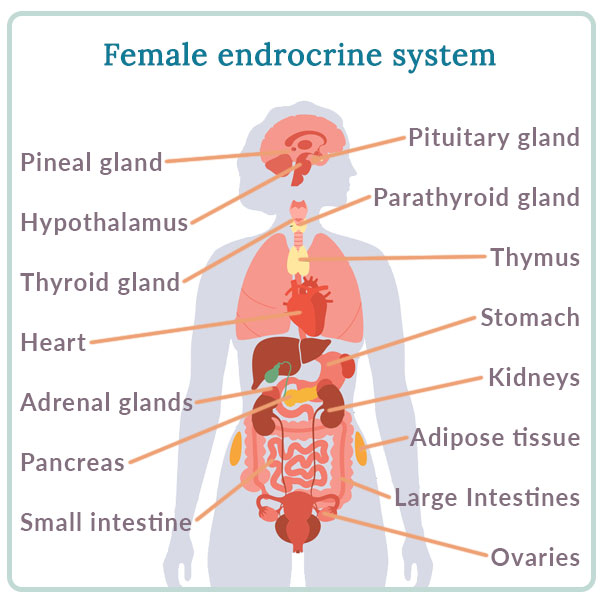Authored by Dr. Mary James, ND
Endocrine disruptors are toxic chemicals that interfere with your body’s ability to function properly and maintain hormonal balance. No matter where you live, you have dozens of toxic substances in your body. Studies show that diverse groups of people from all over the U.S., Europe and Canada — even indigenous tribes in Northern Québec —have absorbed a complex chemical cocktail of many different synthetic substances — including endocrine disruptors that can have a chilling effect on your hormonal health.

How did these chemicals get into everyone’s bodies? Environmental pollutants are easily transported long distances by water and wind to make their way into the food supply. They accumulate as byproducts from eating treated and contaminated food, breathing industrial emissions, and repeatedly using products such as plastic microwave bags, fast-food containers, plastic water bottles, nail polish, and household cleansers, to name just a few.
More than 80,000 chemicals have been registered with the EPA since World War II, with at least 2,000 new ones added every year in the U.S. alone, and it’s not slowing down. We’re all vulnerable to toxic exposure, including children. PCBs and DDT have been detected, for example, in 50% and 70% respectively of kids as young as four years old. The glowing promise of “better living through chemistry” has tragically backfired as pollution intensifies and its associated health hazards become more apparent.
Can environmental regulations protect us from toxins?
Caps are placed on industrial emissions, and “allowable” concentrations of pesticides in foods have been established. A group of some of the most dangerous pesticides was banned in 2001, and a few others are periodically added to the list. States have risk management programs, though some are more progressive and/or aggressive than others. Even though politics do play a part in regulations and limitations on toxins, both Health Canada and the CDC in the U.S. conduct bio-monitoring testing programs, which help measure the “body burden” of toxins. All of this is encouraging.
One of the problems with environmental regulations is that many organic pollutants disintegrate so slowly that banned chemicals persist in our soil, water and food supply — and the human body anyway. There is also evidence of dangerous synergistic effects between chemicals when toxic effects of one chemical are made worse when combined with other chemicals.
Our safety net against toxins has large gaps
Since science mostly examines one compound in isolation (and not usually in people), the combo effect isn’t taken into account when safe limits are established. In one rat study, exposure to a “non-toxic” dose of a pesticide led to a 67-fold increased death rate when carbon tetrachloride was added to the mix. But nobody is exposed to, or stores, just one synthetic chemical.
Another problem is the common practice of replacing old phased-out harmful compounds with others presumed to be safer but that are discovered later to also cause problems. Bio-monitoring of toxic burden is expensive and has not been standardized — and it only measures exposure. It doesn’t examine the full effects and consequences of exposure to these larger amounts of chemicals.
What happens to pollutants and toxins in your body?
Your body isn’t defenseless and has an elaborate detoxification system to eliminate harmful compounds. However, new chemicals are being introduced faster than your body’s ability to adapt. Even the healthiest person has trouble filtering the massive load of toxins in today’s environment.
Most man-made toxins in our environment are “lipophilic” or fat-loving. Toxins gravitate to fatty tissues where they can settle into your body for the long haul. This includes major networking systems like your nervous system and brain, both particularly vulnerable to toxins, along with the immune and endocrine systems. Even toxins that are water-soluble, such as bisphenol A (BPA) or BPS, and don’t get stored in fat, can cause health problems due to repeat exposures over time.
Endocrine disruptors: trouble-making everyday chemicals
Studies have shown that xenobiotics, or those that are foreign to living organisms, can increase risk of health problems, including cancers, cardiovascular disease, autoimmunity, allergies, diabetes, and even weight gain. Toxic exposure in utero has also been shown to alter cellular programming in a way that sets the stage for health problems later in life, and even for subsequent generations.
Since we’re all biochemically unique, some of us are more susceptible to the health effects of toxicity. Many factors affect and influence our ability to manage most toxins and their consequences once they’re in your body. Put simply, some of us are more efficient detoxifiers than others.
Even before symptoms show up, these toxic compounds — fat-soluble or water-soluble — interfere with the essential inner workings of our cells. The most common chemicals we encounter daily may be the most worrisome because they can alter the action of hormones in the body. These compounds are referred to as endocrine-disrupting chemicals (EDCs) — synthetic compounds that mimic natural hormones, but not necessarily in a good way.
EDCs can turn on, turn off, or alter normal hormonal signals, even in extremely low amounts. While EDCs were initially considered xenoestrogens (foreign estrogens), we now know that their biological effects go far beyond those caused by estrogen.
Your endocrine system is an elegantly interconnected network of chemical messengers. Tiny amounts of one hormone exert powerful effects on other hormones and tissues in the body, primarily by fitting into and attaching to receptors on cells. Feedback loops between hormones try to keep everything in balance but disruptions in one part of the system can also have far-reaching — and devastating — effects in other areas.
It’s not hard to upset your hormonal balance and EDCs can act on your body in a few different ways:

1. They can bind to hormone receptors, either triggering excessive hormone action or blocking a natural response (in either case, blood levels of hormone can still measure as normal).
2. They can alter signaling within cells.
3. They can interfere with normal biochemical reactions.
Studies are beginning to illuminate the long-term effects of EDCs. Links between pesticides and frog deformities, fish sex-reversals, and bird infertilities are well-documented. Effects in mammals appear highly individualized, based on factors like age at exposure, genetics, level and duration of exposure, gender, and detoxification capacity.
What we know about the effects of EDCs on humans
For humans, exposure to EDCs has been linked to reproductive disorders, endometriosis, adrenal imbalances, thyroid issues (PCBs, for example, are structurally similar to thyroid hormone), insulin resistance and diabetes, obesity, and various cancers. In one study, elevated levels of pesticides correlated with a four-fold increased risk of breast cancer. Even some cases of mood disorders and autism may relate to endocrine disruptors.
The overall effects on humans are mostly still a worrying mystery because there have never before been so many diverse, man-made and unregulated synthetics at work in our bodies. It’s scary, yes, until you have the information to understand that you do have some control over the outcome. By giving your body the tools it needs to function well, you can optimize your capacity to detoxify and eliminate these toxins from your body. You can also learn more about how to reduce your exposure.
Invisible toxins are absolutely everywhere
Man-made chemicals known or suspected to influence the endocrine system are all around us. Most of the latest “however-did-we-live-without-them” inventions are made with these chemicals. They make plastic products softer and easier to handle, cosmetic creams and lotions smoother and longer-lasting, and clothes and furniture fire retardant. They are in clothing dye (especially denim), cars and computer casings, store receipts, Teflon® coatings, disinfectant bleaches, water bottles, and the linings of canned foods.
These chemicals get free and are diffused throughout the atmosphere by burning industrial waste and leaching into groundwater from landfills. Scientists worry because food is the most significant source of pesticide residues, especially fatty fish and meat, and dairy products. Being aware of the sources of these contaminants is the first step in learning how to avoid them.
Women’s Health Network list of the most common endocrine-disrupting toxins
- Bisphenol A (BPA): Widely used to make polycarbonate plastics like food and drink containers, can linings, toys, baby bottles, dental sealants, flame retardants, plastic wraps and paper receipts. BPA is water-soluble, so it easily leaches into food and water.
- Bisphenol S (BPS): Used as a substitute for BPA, despite having similar health effects. Found in plastic storage containers, plastic water bottles, components of baby bottles and sippy cups, and paper receipts. Like BPA, BPS leaches easily into food and water.
- Phthalates: Added to plastics to make them softer, more flexible, resilient and durable. Found in IV tubing, vinyl flooring, glues, inks, pesticides, detergents, plastic bags, food packaging, children’s toys, shower curtains, soaps, shampoos, perfumes, hair spray and nail polish.
- Parabens: Compounds used as preservatives in thousands of cosmetics, foods and pharmaceutical products.
- PBDEs (polybrominated diphenyl ethers): Found in flame retardants used on furniture, curtains, mattresses, carpets, and casings for televisions and computers. Categorized as a persistent organic pollutant (POP), PBDE is stored in animal fats and found in dairy products, meat, fish, and human breast milk. Also found in house dust.
- PCBs (polychlorinated biphenyls): Highly toxic synthetic chemical compounds found on the list of POPs, once used widely as insulation fluid in electrical transformers, lubricating oil in pipelines, and components of plastics. Also mixed with adhesives, paper, inks, paints and dyes. PCBs are common contaminants of fatty fish and meats. Since 1976, PCBs have been banned in new products, but they are highly stable and degrade very slowly so they persist in the environment.
- Dioxin: General name for a group of hundreds of banned chemicals that are highly persistent in the environment. They are the unintentional byproducts of many industrial processes involving chlorine, including waste incineration, chemical and pesticide manufacturing, and pulp and paper bleaching. Small molecules drift into the atmosphere and end up on soil, where they are eaten by microbes. From there they can pass up the food chain into meat, fish, dairy products and breast milk. Foods represent our largest exposure to dioxin.
- Perfluorinated compounds: Found in stain-, oil-, and stick-resistant products, such as non-stick pans, Scotchguard®-treated upholstery, water-repellent materials, pizza boxes, and microwave popcorn bags. Food is the main source of exposure for most people.
- Pesticides and herbicides: With hundreds of chemicals in these groups, most are organophosphates and organochlorines. Common home sources include Roundup® and other weed killers, rat poisons, flea and tick sprays, pet collars, mosquito repellent, and many household cleansers.
- Heavy metals: Includes cadmium, mercury, arsenic and lead, all with endocrine-disrupting actions. Common sources are fish and shellfish, pressure-treated lumber, industrial manufacturing and waste, PVC plastics, paints, insecticides, fungicides, fertilizers, motor oil, engine exhaust, hair dyes, stained glass, batteries, newsprint, and dental amalgams.

What you can do about endocrine disruptors and other toxins
The quality of air, water, and earth has enormous effects on our health and we are all connected to the world around us. Remember that small changes add up to significant improvements, personally, locally and globally so you can make a difference.
Simply by becoming more aware of endocrine disruptors, you’ll find ways to reduce the potential load of contaminants you come into contact with each day, including plastics, pesticides, building materials, clothing fabric, cleansers, bleach and cosmetics.
The whole process will be less overwhelming if you take it one step at a time:
1. Choose your food wisely. Food is the largest source of non-work related exposure to pesticides, so eat organic whenever possible, and keep track of your animal fat and fish consumption. Certain crops are more heavily sprayed than others. We like to use the Environmental Working Group’s advice when it comes to fruit and vegetables. Avoid foods on their “Dirty Dozen™” list, and select foods from the “Clean 15™.” If you can, consider growing some of your own vegetables. Wash all fruits and vegetables thoroughly and peel them if they weren’t grown organically. Make a fruit wash by diluting soap or mixing water (90%) and vinegar (10%) then rinsing. Trim the fat off meat since it contains more chemicals. Choose wild-caught over farmed fish, and choose smaller fish over larger ones.
2. Ensure optimal nutrition. Every day, take a high-quality, broad-spectrum multivitamin and get adequate essential fatty acids (fish oil in high quality supplements is molecularly distilled to remove toxins). Get enough protein and fiber, and eat colorful, antioxidant-rich fruits and vegetables. Good nutrition gives your body the essential tools it needs to detoxify well.
3. Support your body’s detoxification systems by exercising and sweating on a regular basis. Your skin is a major detox organ so sweating helps. Use a sauna, especially dry infrared. Drink plenty of filtered water to help flush out toxins.
4. Reduce your exposure to non-stick cookware and non-stick food packaging. Cook with stainless steel cookware. Store foods in aluminum foil or glass, instead of cardboard or plastic wrap. Use stainless steel or glass water containers and baby bottles, not plastic ones. When you have to drink water out of a plastic bottle, don’t let it get too hot as heat increases the rate that polycarbons leach into the water. Store foods in glass jars, and choose canned foods labeled “free of bisphenol A.”

5. Check your cosmetics, bug spray, lotions and toiletries for possible toxins. Visit the Campaign for Safe Cosmetics website for a list of chemical-free alternatives.
6. Know your water supply. Find out whether your local community’s water testing program checks for hormone-disrupting chemicals and heavy metals. Household filters can help but since their effectiveness varies, do a little research before buying.
Think Green— for yourself and everyone in your community
Once we decide to participate in creating a cleaner, safer environment, we find more opportunities every day to make a difference that benefits us, and everyone else. Limiting your personal use of toxins makes the world a little cleaner for everyone. Choose newer and greener household cleaning products or the old standby, baking soda and vinegar. Open your windows instead of spraying air freshener. Look for green lawn products and garden services. Hand-wash sweaters instead of having them dry-cleaned. Use reusable bags for groceries.
“Never doubt that a small group of thoughtful, committed citizens can change the world. Indeed, it is the only thing that ever has.”
— Margaret Mead, American cultural anthropologist
You can also ask for green products when you don’t see them in your neighborhood stores. If you’re an organizer, work with others to develop community ordinances regarding the use of chemicals in public places. Support local and federal clean air and water initiatives. Write to your local and state representatives and encourage them to vote for initiatives that help create a healthier future for everyone. Vote for politicians who prioritize cleaning up the environment.
We’re in this endocrine-disrupting world together
While the full effects of endocrine disruptors are still unknown, there have been spikes in infertility rates, hormonal problems, chemical sensitivities, allergies and cancers since their introduction. The scientific evidence suggests a clear connection to endocrine disruptors as we know them.
We need to find better and safer ways to work with nature, not against it. Humans are an amazing species; we can adapt socially and learn at a breathtaking pace — it just takes knowledge, leadership, and commitment. The best way to begin is by implementing changes in your own life. Never underestimate the power of one.
Environmental Protection Agency. Existing Chemicals. EPA Web site: https://www.epa.gov/oppt/existingchemicals/pubs/basicinfo.html. Accessed May 9, 2015.
Stockholm Convention. What are POPs? Available at: https://chm.pops.int/TheConvention/ThePOPs/tabid/673/Default/. Accessed May 9, 2015.
Birnbaum LS, Grandjean P. Alternatives to PFASs: Perspectives on the Science. Environ Health Perspect. 2015 May 1;123(5):A104-A105. Available at: https://ehp.niehs.nih.gov/1509944/. Accessed May 8, 2015.
Crinnion WJ. Environmental medicine, part one: the human burden of environmental toxins and their common health effects. Altern Med Rev. 2000 Feb;5(1):52-63.
Grün F, Blumberg B. Endocrine disrupters as obesogens. Mol Cell Endocrinol. 2009 May 25;304(1-2):19-29.
Crinnion WJ. Organic foods contain higher levels of certain nutrients, lower levels of pesticides, and may provide health benefits for the consumer. Altern Med Rev. 2010 Apr;15(1):4-12.










